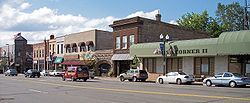Anoka, Minnesota
Anoka, Minnesota | |
|---|---|
 Main Street, downtown Anoka | |
 Location in Anoka County and the state of Minnesota | |
| Country | United States |
| State | Minnesota |
| County | Anoka |
| Founded | 1844 |
| Incorporated | 1878 |
| Government | |
| • Mayor | Bjorn Skogquist |
| Area | |
| • City | 7.2 sq mi (18.6 km2) |
| • Land | 6.7 sq mi (17.3 km2) |
| • Water | 0.5 sq mi (1.3 km2) 6.97% |
| Elevation | 879 ft (268 m) |
| Population (2000) | |
| • City | 18,076 |
| • Density | 2,709.0/sq mi (1,046.4/km2) |
| • Metro | 2,968,805 |
| Time zone | UTC-6 (Central) |
| • Summer (DST) | UTC-5 (Central) |
| ZIP code | 55303 |
| Area code | 763 |
| FIPS code | 27-01720Template:GR |
| GNIS feature ID | 0639396Template:GR |
| Website | http://www.ci.anoka.mn.us |
Anoka is a city in Anoka County, Minnesota, United States. The population was 18,076 at the 2000 census. It is the county seat of Anoka CountyTemplate:GR. Anoka is also the self-proclaimed "Halloween Capital of the World", due to the fact that it hosted the first Halloween parade in 1920. In 1937, city officials persuaded the United States Congress to officially grant the title. It continues to celebrate the holiday each year with several parades.
U.S. Routes 10 / 169 and Minnesota State Highway 47 are three of the main arterial routes in the city.
History
The site which is now Anoka was first settled by immigrants in 1844. By the mid-1850s, a town had grown, including a school, store, and flour mill. The city was formally incorporated in 1878. The name Anoka was derived from two Indian words. The native Dakota used A-NO-KA-TAN-HAN, meaning "on both sides", or "from both sides", referring to its location on the banks of the Rum River. The native Ojibwa used ON-O-KAY, meaning "working waters". [citation needed]
Anoka makes a strong claim for providing the first volunteers to the Union Army during the Civil War, noted by a small historical plaque standing at the corner of West Main Street and Park Street. Alexander Ramsey, Minnesota's governor in 1861, was in Washington, D.C. when Fort Sumter was fired upon. He immediately offered a regiment to the War Department, and telegraphed former governor Willis Gorman and Lieutenant Governor Ignatius L. Donnelly that same morning. Gorman, attending a district court session in Anoka, received the note by messenger from St. Paul and called a court recess, asking for volunteers. Aaron Greenwald, who has an "island" named after him on Lake George, and five others stepped forward; Greenwald was the first to sign. He died July 2, 1863, during the 1st Minnesota Regiment's famous charge at Gettysburg.
In 2000, Anoka elected 22-year old Bjorn Skogquist as mayor. Skogquist was re-elected in 2002, 2004 and 2006.
Anoka will have one of the first six stations of the Northstar Corridor commuter rail line connecting the northeast suburbs and downtown Minneapolis; the line is set for completion in 2009.[1]
Geography
Anoka lies at the confluence of the Rum and Mississippi Rivers, about 20 miles (30 km) northwest of Minneapolis. According to the United States Census Bureau, the city has a total area of 7.2 square miles (18.6 km²), of which, 6.7 square miles (17.3 km²) of it is land and 0.5 square miles (1.3 km²) of it (6.97%) is water. Adjacent communities include Dayton, Ramsey, Andover, Coon Rapids, and Champlin. The USGS tracks the town by the ID 639396 and the coordinates of 45°11′52″N, 093°23′14″W[2] 45°11′52″N 093°23′14″W / 45.19778°N 93.38722°W
Demographics

As of the censusTemplate:GR of 2000, there were 18,076 people, 7,262 households, and 4,408 families residing in the city. The population density was 2,709.0 people per square mile (1,046.4/km²). There were 7,398 housing units at an average density of 1,108.7/sq mi (428.2/km²). The racial makeup of the city was 93.15% White, 2.47% African American, 1.05% Native American, 0.93% Asian, 0.03% Pacific Islander, 0.51% from other races, and 1.86% from two or more races. Hispanic or Latino of any race were 1.93% of the population.
There were 7,262 households out of which 30.9% had children under the age of 18 living with them, 44.5% were married couples living together, 12.0% had a female householder with no husband present, and 39.3% were non-families. 31.9% of all households were made up of individuals and 11.2% had someone living alone who was 65 years of age or older. The average household size was 2.38 and the average family size was 3.03.
In the city the population was spread out with 24.6% under the age of 18, 11.1% from 18 to 24, 32.2% from 25 to 44, 20.5% from 45 to 64, and 11.6% who were 65 years of age or older. The median age was 34 years. For every 100 females there were 99.2 males. For every 100 females age 18 and over, there were 97.1 males.
The median income for a household in the city was $42,659, and the median income for a family was $55,311. Males had a median income of $37,930 versus $27,753 for females. The per capita income for the city was $21,367. About 4.7% of families and 6.8% of the population were below the poverty line, including 9.2% of those under age 18 and 5.4% of those age 65 or over.
Education
- Anoka Technical College
- Secondary Technical Education Program or S.T.E.P. High School
- Anoka-Hennepin School District 11
- St. Stephens Catholic School
Sites of interest
- Anoka Metro Regional Treatment Center
- Anoka County Library
- Goodrich Field
- Windego Park Open Air Auditorium
- Rum River Nature Area
Notable residents
- Bill Tuttle, major league baseball player of the 1950s and 1960s who, in his later years, crusaded against the use of chewing tobacco.
- Gretchen Carlson, FOX News Channel anchor, 1989's Miss America, and celebrity spokesperson for March of Dimes
- While serving in the U.S. Congress from 1993 to 2000, Senator Rod Grams kept an office in downtown Anoka
- Larry Foyen, trumpet player for Maynard Ferguson and Ray Charles
- Garrison Keillor, radio host of A Prairie Home Companion and author, was born in Anoka and graduated from Anoka High School
- Brandon Paulson, U.S. Olympic wrestler, graduated from Anoka High School in 1992.
- Briana Scurry, U.S. national women's soccer goalie, graduated from Anoka High School in 1989
- Richard K. Sorenson, Master Sergeant, USMC, was awarded the Medal of Honor for his heroism in the Marshall Islands of the South Pacific in February 1944. He was the son of Mr. and Mrs. Carl Sorenson of Benton Street, Anoka.[3]
- Bjorn E. Skogquist, Mayor of Anoka 2001-present. Elected youngest mayor ever in Anoka. At 22 years old, he was the youngest mayor in Minnesota when first elected.
- Reginald Berg, U.S. minor league hockey player. Currently in Florida.
- Michele Bachmann, U.S. Representative from MN's 6th District, was born and raised in Anoka and graduated from Anoka High School in 1974.
- Alan Haskvitz, inducted into the National Teachers Hall of Fame.
- Sean Sherk, former UFC lightweight champion.
See also
References
- ^ Paul Levy, Northstar set to roll, but how far?, Star Tribune, December 11, 2007.
- ^ USGS's Geographic Names Information System entry for Anoka, MN, ID#639396, Entry date 11-Jan-1980
- ^ Richard K. Sorenson, USMC History Division, web site accessed 20 January 2007

